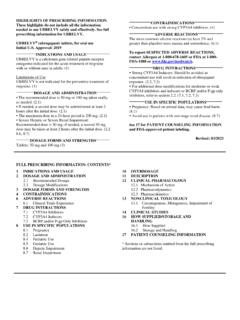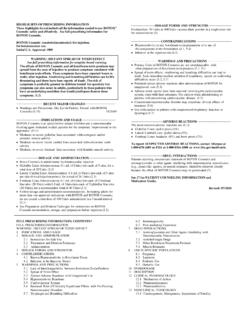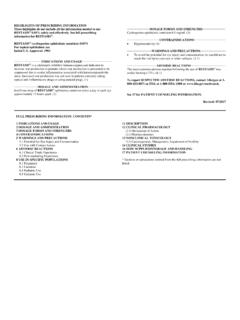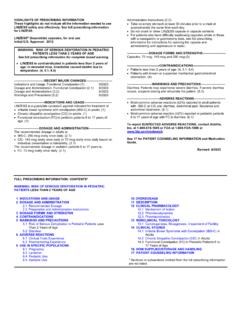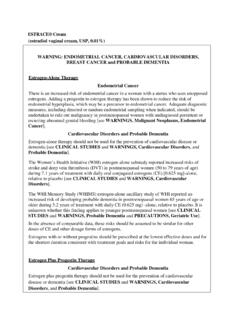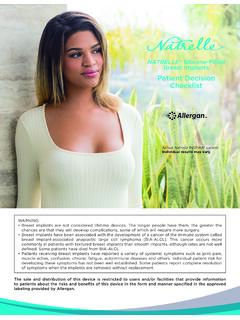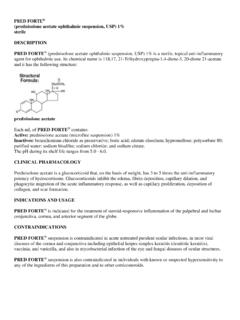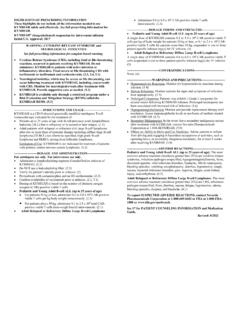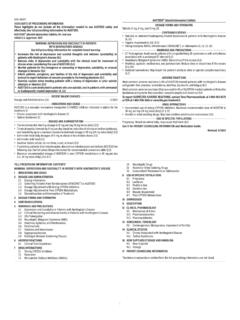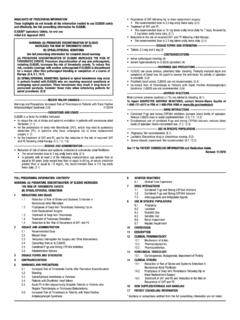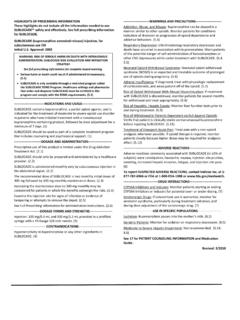Transcription of HIGHLIGHTS OF PRESCRIBING INFORMATION BOTOX
1 HIGHLIGHTS OF PRESCRIBING INFORMATION These HIGHLIGHTS do not include all the INFORMATION needed to use BOTOX safely and effectively. See full PRESCRIBING INFORMATION for BOTOX . BOTOX (onabotulinumtoxinA) for injection, for intramuscular, intradetrusor, or intradermal use Initial Approval: 1989 _____RECENT MAJOR CHANGES_____ Indications and Usage, Pediatric Detrusor Overactivity associated with a Neurologic Condition ( ) 2/2021 Dosage and Administration, Pediatric Detrusor Overactivity associated with a Neurologic condition ( ) 2/2021 Dosage and Administration, Adult Spasticity ( ) 7/2021 _____INDICATIONS AND USAGE_____BOTOX is an acetylcholine releaseinhibitor and a neuromuscular blocking agent indicated for.
2 Treatment of overactive bladder (OAB) with symptoms of urge urinary incontinence, urgency, and frequency, in adults who have an inadequate response to or are intolerant of an anticholinergic medication ( ) Treatment of urinary incontinence due to detrusor overactivity associated with a neurologic condition [ , spinal cord injury (SCI), multiple sclerosis (MS)] in adults who have an inadequate response to or are intolerant of an anticholinergic medication ( ) Treatment of neurogenic detrusor overactivity (NDO) in pediatric patients 5 years of age and older who have an inadequate response to or are intolerant of anticholinergic medication.
3 ( ) Prophylaxis of headaches in adult patients with chronic migraine ( 15 days per month with headache lasting 4 hours a day or longer) ( ) Treatment of spasticity in patients 2 years of age and older ( ) Treatment of cervical dystonia in adult patients, to reduce the severity of abnormal head position and neck pain ( ) Treatment of severe axillary hyperhidrosis that is inadequately managed by topical agents in adult patients ( ) Treatment of blepharospasm associated with dystonia in patients 12 years of age and older ( ) Treatment of strabismus in patients 12 years of age and older ( ) Limitations of Use Safety and effectiveness of BOTOX have not been established for: Prophylaxis of episodic migraine (14 headache days or fewer per month) ( ) Treatment of hyperhidrosis in body areas other than axillary ( ) _____DOSAGE AND ADMINISTRATION_____ Follow indication-specific dosage and administration recommendations.
4 In a 3 month interval, do not exceed a total dose of: Adults: 400 Units Pediatrics: the lesser of 10 Units/kg or 340 Units ( ) See Preparation and Dilution Technique for instructions on BOTOX reconstitution, storage, and preparation before injection ( ) Overactive Bladder: Recommended total dose 100 Units, as mL (5 Units) injections across 20 sites into the detrusor ( ) Adult Detrusor Overactivity associated with a Neurologic Condition: Recommended total dose 200 Units, as 1 mL (~ Units) injections across 30 sites into the detrusor ( ) Pediatric Detrusor Overactivity associated with a Neurologic Condition: mL injections across 20 sites into the detrusor ( ) Greater than or equal to 34 kg: Recommended total dose is 200 Units Less than 34 kg: Recommended total dose is 6 Units/kg Chronic Migraine: Recommended total dose 155 Units, as mL (5 Units) injections per each site divided across 7 head/neck muscles ( ) Adult Upper Limb Spasticity: Recommended total dose up to 400 Units divided among affected muscles ( ) Adult Lower Limb Spasticity: Recommended total dose 300 Units to 400 Units divided across ankle and toe muscles ( ) Pediatric Upper Limb Spasticity.
5 Recommended total dose 3 Units/kg to 6 Units/kg (maximum 200 Units) divided among affected muscles ( ) Pediatric Lower Limb Spasticity: Recommended total dose 4 Units/kg to 8 Units/kg (maximum 300 Units) divided among affected muscles ( ) Cervical Dystonia:Base dosing on the patient s head and neck position, localization of pain, muscle hypertrophy, patient response, and adverseevent history; use lower initial dose in botulinum toxin na ve patients ( ) Axillary Hyperhidrosis:50 Units per axilla ( ) Units into each of 3 sites per affected eye ( ) Strabismus:The dose is based on prism diopter correction or previous response to treatment with BOTOX ( )_____DOSAGE FORMS AND STRENGTHS_____For Injection: 100 Units or 200 Units vacuum-dried powder in a single-dose vial (3) _____CONTRAINDICATIONS_____ Hypersensitivity to any botulinum toxin preparation or to any of the components in the formulation (4, , 6) Infection at the proposed injection site (4) Intradetrusor Injections.
6 Urinary tract infection or urinary retention (4)_____WARNINGS AND PRECAUTIONS_____ Spread of toxin effects; swallowing and breathing difficulties can lead to death. Seek immediate medical attention if respiratory, speech or swallowing difficulties occur ( , ) Potency Units of BOTOX are not interchangeable with other preparations of botulinum toxin products ( , 11) Potential serious adverse reactions after BOTOX injections for unapproved uses ( ) Concomitant neuromuscular disorder may exacerbate clinical effects of treatment ( ) Use with caution in patients with compromised respiratory function ( , , ) Corneal exposure and ulceration due to reduced blinking may occur with BOTOX treatment of blepharospasm ( )
7 Retrobulbar hemorrhages and compromised retinal circulation may occur with BOTOX treatment of strabismus ( ) Bronchitis and upper respiratory tract infections in patients treated for spasticity ( ) Urinary tract infections in patients treated for OAB ( ) Urinary retention: Post-void residual urine volume should be monitored in patients treated for OAB or adult detrusor overactivity associated with a neurologic condition who do not catheterize routinely, particularly patients with multiple sclerosis or diabetes mellitus. ( ) _____ADVERSE REACTIONS_____The most common adverse reactions ( 5% and >placebo, if applicable) are ( ): OAB: urinary tract infection, dysuria, urinary retention Adult Detrusor Overactivity associated with a neurologic condition: urinary tract infection, urinary retention Pediatric Detrusor Overactivity associated with a neurologic condition: urinary tract infection, leukocyturia, bacteriuria Chronic Migraine: neck pain, headache Adult Spasticity: pain in extremity Pediatric Spasticity: upper respiratory tract infection Cervical Dystonia.
8 Dysphagia, upper respiratory infection, neck pain, headache, increased cough, flu syndrome, back pain, rhinitis Axillary Hyperhidrosis: injection site pain and hemorrhage, non-axillary sweating, pharyngitis, flu syndrome To report SUSPECTED ADVERSE REACTIONS, contact Allergan at 1-800-678-1605 or FDA at 1-800-FDA-1088 or _____DRUG INTERACTIONS_____Patients receiving concomitant treatment of BOTOX and aminoglycosides or other agents interfering with neuromuscular transmission ( , curare-like agents), or muscle relaxants, should be observed closely because the effect of BOTOX may be potentiated ( , )_____USE IN SPECIFIC POPULATIONS_____ Pregnancy: Based on animal data, may cause fetal harm.
9 ( ) See 17 for PATIENT COUNSELING INFORMATION and Medication Guide. Revised: 7/2021 WARNING: DISTANT SPREAD OF TOXIN EFFECT See full PRESCRIBING INFORMATION for complete boxed warning. The effects of BOTOXand all botulinum toxin products may spread from the area of injection to produce symptoms consistent with botulinum toxin effects. These symptoms have been reported hours to weeks after injection. Swallowing and breathing difficulties can be life threatening and there have been reports of death. The risk of symptoms is probably greatest in children treated for spasticity but symptoms can also occur in adults, particularly in those patients who have an underlying condition that would predispose them to these symptoms.
10 ( ) * Sections or subsections omitted from the full PRESCRIBING INFORMATION are not PRESCRIBING INFORMATION INDICATIONS AND USAGE Adult Bladder Dysfunction Overactive Bladder BOTOX for injection is indicated for the treatment of overactive bladder with symptoms of urge urinary incontinence, urgency, and frequency, in adults who have an inadequate response to or are intolerant of an anticholinergic medication. Detrusor Overactivity associated with a Neurologic Condition BOTOXis indicated for the treatment of urinary incontinence due to detrusor overactivity associated with a neurologic condition ( , SCI, MS) in adults who have an inadequate response to or are intolerant of an anticholinergic medication.

